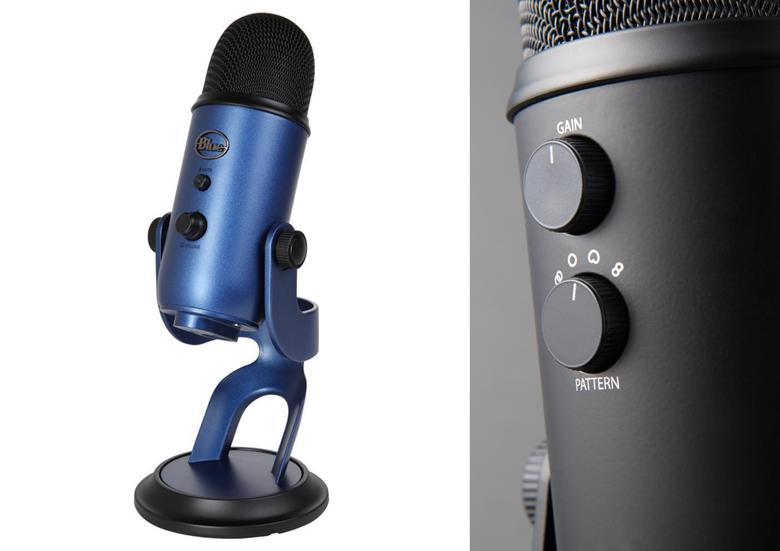Tech Reviews: Yeti
Tim Hallas
Monday, March 1, 2021
Tim Hallas reviews the Yeti from Blue Mics.

For lots of music teachers, the current lockdown means more sitting in front of laptops at dining tables or in spare rooms and using low-quality laptop microphones to try to record or live-stream lessons for students.
One of the things that my department has invested in over the last few months is a dedicated mic for delivering online lessons. The mic in question is the Yeti from Blue Mics, and this is advertised as a dedicated podcasting mic that connects straight to a computer with no need for a separate interface or software.
Using the mic
The Yeti has been around for some time but is still very popular and is selling in vast quantities from well-known electronic retailers. The first thing to notice when opening the box is the sheer bulk of the microphone. It contains three separate diaphragms for capturing sound in any direction and to be a mic for all situations. However, it comes with a dedicated stand, and when mounted, the microphone feels sturdy and you would be hard pushed to knock it over.
The Yeti has four main controls: input gain, polar pickup pattern selection, output volume and a mute switch. The three rotary controls all feel sturdy, but the mute button feels a little flimsy. In reality, I don't end up using the mute button very much as I mute the mic in my teaching software, so I'm not too worried about this.
The ability to set the gain level is a helpful bonus because a lot of similar products do this automatically, which can result in unnecessarily loud or quiet levels. When done automatically, systems often add compression, which can result in a consistent output volume, but doesn't allow for specific control. The ability to set gain on the mic means it can be configured for a range of different teaching scenarios.
Polar pattern
For non-specialists, instructions on ‘changing polar pattern’ might as well be in ancient Greek. What this means is that it changes the direction of the microphone capture. The idea with the Yeti is that it could be positioned in front of one speaker or a number of presenters around a table and capture them all equally well depending on which setting is used.
Obviously, given the stay-at-home order, it's unlikely you'll be teaching in a group or recording a round-table presentation. However, it does have some use. For instance, if you want to teach in the same room as a piano but it's not that close to the table you are using for your laptop, by setting the Yeti to omnidirectional it should be able to capture your speech and the piano equally well wherever you are in the room (but you may need to adjust the gain depending on how close or far away each sound source is from the microphone).
The simplest thing to do if you aren't sure is to set it to the cardioid position (second from the right and looks like a small heart). This is the pickup pattern that most mics feature and will capture the sounds that are in front of the microphone.
The sound
This isn't a super high-quality microphone. You aren't going to find the Yeti in any high-end studios. However, the sound is pretty good, doesn't sound compressed and captures all of the key frequencies necessary. For basic recording and capture of speech and simple music, the Yeti performs excellently.
Connectivity
The Yeti only has two connections on it – a mini-USB socket for connecting to a computer and a mini-jack for connecting a pair of headphones. Sadly, there isn't an XLR socket for connecting the Yeti to a mixer or any other audio device. But there is a more expensive model that does include this (the Yeti Pro) if this is something that you need.
The advantage of the Yeti is that it doesn't require any additional equipment to have access to a better-quality microphone. The unit contains the mic, the preamp and the digital convertor to turn it into a USB signal. This is one of the reasons it's so bulky!
The microphone will connect to the computer with the standard mini-USB-to-USB cable commonly used to charge phones, but if you are using a more modern Mac you may need a convertor to connect to the USB-C sockets. If you are going to use headphones with the Yeti, I'd recommend not using phone headphones (or ones with a built-in mic) because the extra connection on the plug can sometime confuse systems like this. When headphones are connected, the volume for these is adjusted by the Level control on the front of the mic.
Summary
The Yeti is an excellent microphone and a real step-up from the built-in microphones found in most computers. Although designed for podcasting, the Yeti is a great mic for remote teaching because it is sturdy and raises the quality of audio available.
While not cheap, the Yeti offers good value because it will still have great use in practice rooms once we are back in schools. The mic is well built and will last a number of years, even after being abused by students. Totally recommended.
The Yeti retails at £119. To find out more, visit bluemic.com

